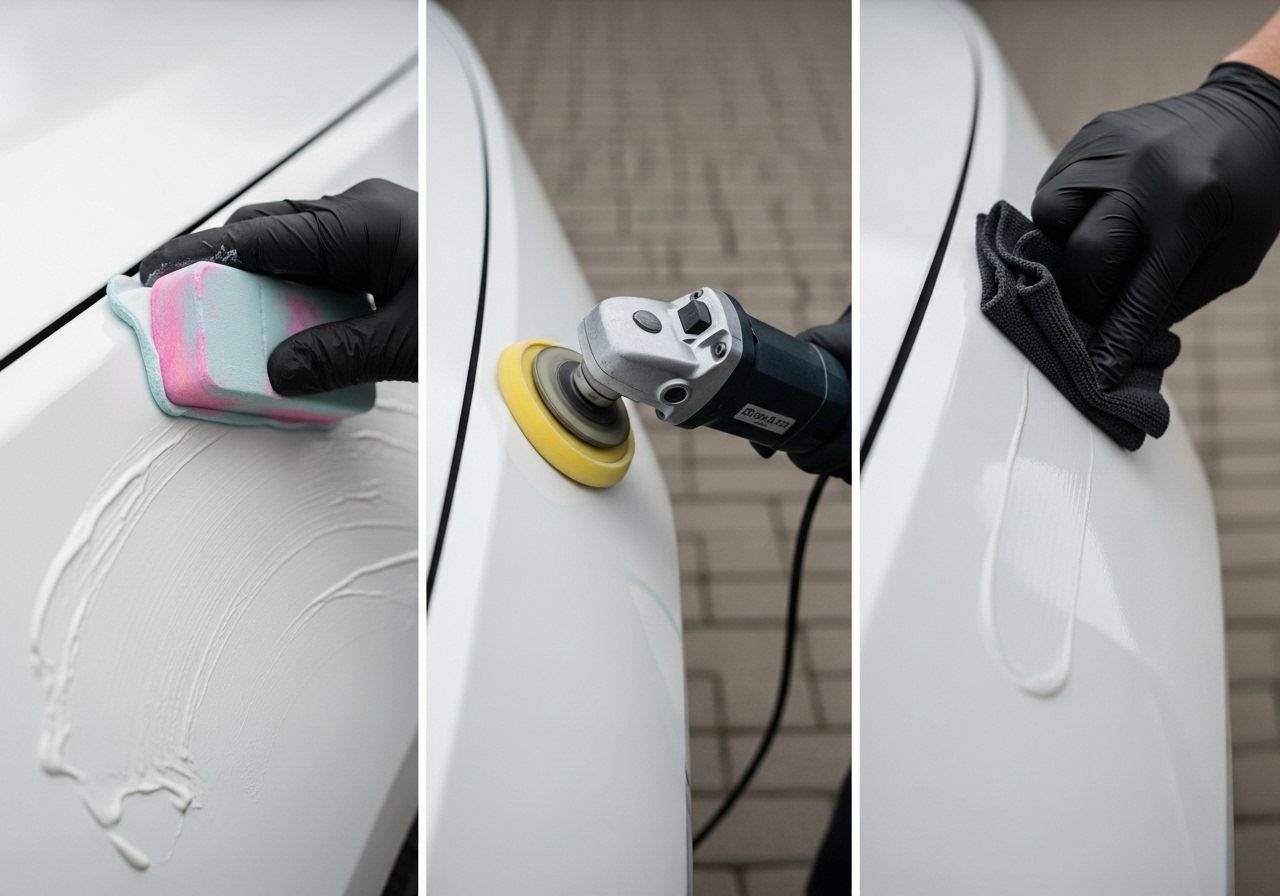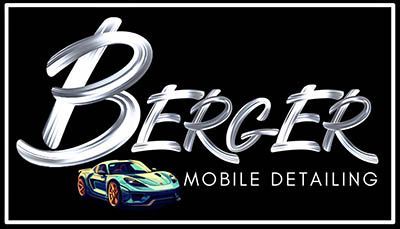
How does Paint Correction Help your Car?
Paint correction sounds intense, maybe even a little bit intimidating. But what is paint correction and what does paint correction do, really?
Let’s cut to the chase. It’s not about hiding things. It's about fixing them. Permanently.
Over time, your car deals with microscopic scratches, swirl marks from automatic car washes, oxidation from the sun, and etching from bird droppings.
These imperfections are like tiny valleys and ridges in the surface of your car's clear coat. When light hits them, it scatters in a million different directions instead of reflecting back cleanly. The result? A dull, hazy, and lifeless finish. Paint correction is the art of leveling that surface back to a perfectly flat, mirror-like plane.
Automotive Paint Correction is Not a Cover-Up
Here’s the biggest misconception about auto paint detailing: that you can just wax the scratches away. Applying wax or sealant to a swirled-out car is like putting a coat of gloss on a scratched-up wooden table. Sure, it might look a little better for a minute, but the underlying damage is still there, just filled in temporarily.
Automotive paint correction is different. It’s a mechanical process that carefully removes an incredibly thin layer of that damaged clear coat—we’re talking microns, thinner than a sheet of paper—to reveal the fresh, flawless paint underneath. It’s not filling, and it's not hiding. It is the literal restoration of your vehicle's finish to a state that is often better than when it left the factory.
Even brand-new cars often need some level of car paint correction thanks to improper washing at the dealership or fine scratches from transport protection plastics.
What Can Be Fixed with Paint Correction?
So, what exactly are we fighting against? Paint correction is the ultimate weapon against a whole host of common paint defects that accumulate over time.
- Swirl Marks: The most common culprits. These are microscopic, circular scratches caused by improper washing and drying techniques (think dirty sponges or gritty towels).
- Light Scratches: Surface-level scratches that haven't gone through the clear coat. The kind you might get from a bush, a key fob, or a stray zipper on a jacket.
- Water Spots: Mineral deposits left behind from hard water that can etch into the paint if left for too long.
- Oxidation: That chalky, faded look you see on older cars, especially red ones. The sun's UV rays have broken down the clear coat, dulling the color.
- Bird Dropping Etching: The acidic nature of bird droppings can eat into the clear coat, leaving a permanent, dull spot.
It's important to have realistic expectations. If a scratch is deep enough to catch your fingernail, it's likely gone through the clear coat and into the color coat or primer. While paint correction can often make these scratches far less noticeable, it can't magically add paint back. But for everything living in that top layer of clear coat? It's fair game.

The Core Paint Correction Steps: How It’s Done
Achieving the best car paint correction isn't a quick buff-and-shine. It's a meticulous, multi-stage process that requires patience, skill, and the right tools. While every car is unique, the foundational paint correction steps remain the same.
Step 1: The Decontamination Phase
You can't perform surgery in a dirty room. Before any polishing machine touches the paint, the vehicle has to be surgically clean. This goes way beyond a simple wash.
- Meticulous Hand Wash: Using pH-neutral soap and the two-bucket method to safely lift away loose dirt and grime.
- Iron Decontamination: A chemical spray is used to dissolve embedded iron particles (mostly from brake dust) that feel like tiny specs of sand on the paint.
- Clay Bar Treatment: A special detailing clay is glided across the paint with a lubricant. This physically pulls out any remaining bonded contaminants—like tree sap and road tar—leaving the surface incredibly smooth. If you skip this, you're just grinding those contaminants into the paint during the polishing stage.
Only after the paint is squeaky clean can the real auto detailing paint restoration begin. This prep work is non-negotiable and is a hallmark of any true professional service.
Step 2: The Correction Stage
With a perfectly clean canvas, it's time for the actual car color correction. This is where skill, experience, and the right tools make all the difference. It's not a one-size-fits-all approach; it's a carefully tailored process that can involve one or several stages of machine polishing.
- The Compounding Stage: Think of this as the heavy-lifting phase. Using a dual-action or rotary polisher, a more abrasive compound, and a cutting pad, the detailer carefully works panel by panel to level the clear coat and remove the deepest scratches and swirl marks. This step is what removes the bulk of the damage, but it often leaves behind its own very fine haze or micro-marring.
- The Polishing/Finishing Stage: Now, the artistry begins. The detailer switches to a much finer polish and a softer finishing pad. This step refines the surface, removing the haze left by the compounding stage and bringing out that incredible gloss, clarity, and depth. The paint goes from just being flat to looking like a pool of liquid color.
Depending on the severity of the paint defects, this process can be repeated with progressively finer polishes. A simple one-step correction might be enough for a car with light swirls, while a vehicle with years of neglect might require a more intensive process, like a full Stage 3 Paint Correction, to achieve that flawless, mirror-like finish.
Step 3: Protection is Paramount
After hours of meticulous work, the paint is perfect. Now what? You have to protect it. Leaving freshly corrected paint exposed to the elements is like buying a masterpiece and leaving it out in the rain. This final step is crucial for locking in the results.
- Wipe Down: The vehicle is carefully wiped down with a special solution to remove any polishing oils, ensuring the protective layer can bond directly to the paint.
- Application of Protection: A layer of protection is applied. This could be a high-quality wax, a synthetic sealant, or, for the ultimate in durability and gloss, a professional-grade ceramic coating. This protective layer becomes the new surface of your car, shielding the perfected paint from UV rays, dirt, and chemicals.
So, What Does Paint Correction Do for YOU?
Okay, that's the technical stuff. But what does it mean for you, the car owner? What's the real-world payoff for investing in the best car paint correction you can get
It’s about more than just removing a few scratches. It's a total transformation.
- Jaw-Dropping Visuals: The number one benefit is the incredible visual impact. The process restores a deep, wet gloss that makes the color pop in a way you probably haven't seen since the day it was made. Reflections become sharp and clear, not hazy and distorted.
- Increases Your Car's Value: A car with a flawless, glossy finish is perceived as being meticulously maintained. Whether you're planning to sell your car soon or years from now, a paint-corrected vehicle will always command a higher resale value than one with a dull, swirled finish.
- Makes Cleaning Easier: A perfectly smooth, decontaminated surface doesn't hold onto dirt and grime the way a rough, scratched one does. When topped with a ceramic coating, the surface becomes hydrophobic (water-repellent), and washing your car becomes ridiculously easy.
- Pride of Ownership: Let's be honest. There's a deep satisfaction that comes from having a car that looks absolutely stunning. It makes you turn back for one last look after you park. That feeling of pride is something you can't put a price tag on.
Get Professional Detailing Services Today
For professional car detailing services that deliver exceptional results, contact Berger Mobile Detailing at (704) 776-6789. Our experienced team provides comprehensive interior and exterior care using proven methods and premium products, ensuring your vehicle receives the thorough attention it deserves while protecting your investment for years to come.
Why Choose Berger Mobile Detailing?
- Mobile service that comes to you
- Experienced, professional detailers
- Premium products and proven techniques
- Serving Northern Virginia and surrounding areas
- Satisfaction guaranteed
